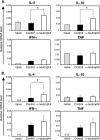Neutrophils contribute to development of a protective immune response during onset of infection with Leishmania donovani
- PMID: 18056477
- PMCID: PMC2223441
- DOI: 10.1128/IAI.01388-07
Neutrophils contribute to development of a protective immune response during onset of infection with Leishmania donovani
Abstract
Neutrophils are key components of the inflammatory response and as such contribute to the killing of microorganisms. In addition, recent evidence suggests their involvement in the development of the immune response. The role of neutrophils during the first weeks post-infection with Leishmania donovani was investigated in this study. When L. donovani-infected mice were selectively depleted of neutrophils with the NIMP-R14 monoclonal antibody, a significant increase in parasite numbers was observed in the spleen and bone marrow and to a lesser extent in the liver. Increased susceptibility was associated with enhanced splenomegally, a delay in the maturation of hepatic granulomas, and a decrease in inducible nitric oxide synthase expression within granulomas. In the spleen, neutrophil depletion was associated with a significant increase in interleukin 4 (IL-4) and IL-10 levels and reduced gamma interferon secretion by CD4(+) and CD8(+) T cells. Increased production of serum IL-4 and IL-10 and higher levels of Leishmania-specific immunoglobulin G1 (IgG1) versus IgG2a revealed the preferential induction of Th2 responses in neutrophil-depleted mice. Altogether, these data suggest a critical role for neutrophils in the early protective response against L. donovani, both as effector cells involved in the killing of the parasites and as significant players influencing the development of a protective Th1 immune response.
Figures






Similar articles
-
The IL-33/ST2 axis is associated with human visceral leishmaniasis and suppresses Th1 responses in the livers of BALB/c mice infected with Leishmania donovani.mBio. 2013 Sep 17;4(5):e00383-13. doi: 10.1128/mBio.00383-13. mBio. 2013. PMID: 24045639 Free PMC article.
-
The capacity to produce IFN-gamma rather than the presence of interleukin-4 determines the resistance and the degree of susceptibility to Leishmania donovani infection in mice.J Interferon Cytokine Res. 2000 Jan;20(1):63-77. doi: 10.1089/107999000312748. J Interferon Cytokine Res. 2000. PMID: 10670653
-
Leishmania donovani phosphoproteins pp41 and pp29 re-establishes host protective immune response in visceral leishmaniasis.Parasitol Int. 2015 Feb;64(1):18-25. doi: 10.1016/j.parint.2014.08.004. Epub 2014 Sep 16. Parasitol Int. 2015. PMID: 25224164
-
Immune evasive mechanisms contributing to persistent Leishmania donovani infection.Immunol Res. 2010 Jul;47(1-3):14-24. doi: 10.1007/s12026-009-8135-4. Immunol Res. 2010. PMID: 20087685 Review.
-
The Equivocal Role of Th17 Cells and Neutrophils on Immunopathogenesis of Leishmaniasis.Front Immunol. 2017 Oct 30;8:1437. doi: 10.3389/fimmu.2017.01437. eCollection 2017. Front Immunol. 2017. PMID: 29163510 Free PMC article. Review.
Cited by
-
IL-17A promotes susceptibility during experimental visceral leishmaniasis caused by Leishmania donovani.FASEB J. 2016 Mar;30(3):1135-43. doi: 10.1096/fj.15-277202. Epub 2015 Nov 18. FASEB J. 2016. PMID: 26581600 Free PMC article.
-
Immunopathogenesis of non-healing American cutaneous leishmaniasis and progressive visceral leishmaniasis.Semin Immunopathol. 2012 Nov;34(6):735-51. doi: 10.1007/s00281-012-0350-8. Epub 2012 Oct 11. Semin Immunopathol. 2012. PMID: 23053396 Free PMC article. Review.
-
Possibilities and challenges for developing a successful vaccine for leishmaniasis.Parasit Vectors. 2016 May 12;9(1):277. doi: 10.1186/s13071-016-1553-y. Parasit Vectors. 2016. PMID: 27175732 Free PMC article. Review.
-
Cutting edge: IL-1β processing during Pseudomonas aeruginosa infection is mediated by neutrophil serine proteases and is independent of NLRC4 and caspase-1.J Immunol. 2012 Nov 1;189(9):4231-5. doi: 10.4049/jimmunol.1201447. Epub 2012 Sep 28. J Immunol. 2012. PMID: 23024281 Free PMC article.
-
The impact of vector-mediated neutrophil recruitment on cutaneous leishmaniasis.Cell Microbiol. 2009 Sep;11(9):1290-6. doi: 10.1111/j.1462-5822.2009.01348.x. Epub 2009 Jun 22. Cell Microbiol. 2009. PMID: 19545276 Free PMC article. Review.
References
-
- Allenbach, C., C. Zufferey, C. Perez, P. Launois, C. Mueller, and F. Tacchini-Cottier. 2006. Macrophages induce neutrophil apoptosis through membrane TNF, a process amplified by Leishmania major. J. Immunol. 1766656-6664. - PubMed
-
- Bacellar, O., M. Barral-Netto, R. Badaro, and E. M. Carvalho. 1991. Gamma interferon production by lymphocytes from children infected with L. chagasi. Braz. J. Med. Biol. Res. 24791-795. - PubMed
-
- Bacellar, O., C. Brodskyn, J. Guerreiro, M. Barral-Netto, C. H. Costa, R. L. Coffman, W. D. Johnson, and E. M. Carvalho. 1996. Interleukin-12 restores interferon-gamma production and cytotoxic responses in visceral leishmaniasis. J. Infect. Dis. 1731515-1518. - PubMed
Publication types
MeSH terms
Substances
LinkOut - more resources
Full Text Sources
Research Materials

